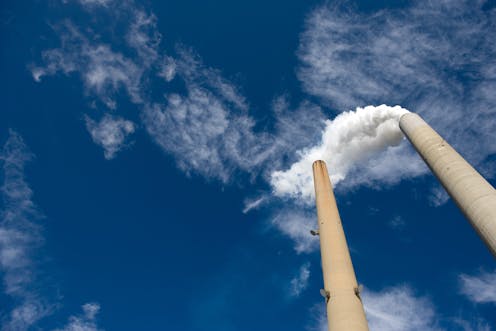The Supreme Court has curtailed EPA's power to regulate carbon pollution – and sent a warning to other regulators
- Written by Patrick Parenteau, Professor of Law, Vermont Law School

In a highly anticipated but not unexpected 6-3 decision, the Supreme Court ruled on June 30, 2022, that the Obama administration’s Clean Power Plan exceeded the U.S. Environmental Protection Agency’s authority[1] under the Clean Air Act.
The ruling doesn’t take away the EPA’s power to regulate carbon emissions from power plants, but it makes federal action harder by requiring the agency to show that Congress has charged it to act – in an area where Congress has consistently failed to act[2].
The Clean Power Plan, the policy at the heart of the ruling, never took effect because the court blocked it in 2016, and the EPA now plans to develop a new policy instead. Nonetheless, the court went out of its way to strike it down in this case and reject the agency’s interpretation of what the Clean Air Act permitted.
Having said what the EPA cannot do, the court gave no guidance on what the agency can do about this urgent problem. Beyond climate policy, the ruling poses serious questions about how the court will view other regulatory programs.
Remaking the electricity sector
The Clean Power Plan would have set targets for each state to reduce carbon dioxide emissions from electric power plants. Utilities could meet these targets[3] by improving efficiency at existing coal-fired power plants and by “generation shifting” – producing more power from natural gas and renewable sources like wind and solar.
In a 2014 video, President Barack Obama describes his administration’s plans to regulate carbon pollution from the energy sector.In the EPA’s view, this sectorwide shift to cleaner sources represented the “best system of emission reduction,” a statutory term in the 1970 Clean Air Act. Coal companies and Republican-led states contended that the changes the agency envisioned exceeded its authority.
Chief Justice John Roberts framed the issue as a “major question,” a doctrine that the court has invoked in only a handful of cases[4]. It holds that agencies may not regulate on questions of “vast economic or political significance” without clear directions from Congress[5].
In the most prominent example, in 2000 the court invalidated the Food and Drug Administration’s attempt to regulate tobacco[6]. The ruling held that this had never been part of the agency’s mission, no law gave the FDA clear authority over tobacco, and Congress had not directed the FDA to take such action.
The major question doctrine builds on a more established but increasingly disfavored principle of administrative law, Chevron deference[7], which requires courts to defer to an agency’s reasonable interpretation of an ambiguous statute. In my view, however, the Supreme Court is using the major question doctrine to take on authority to decide what Congress meant, without regard to the agency’s expert views or policy judgments.
A rebuke to EPA
In one sense, the majority opinion is fairly narrow. As Roberts writes: “[T]he only interpretive question before us, and the only one we answer, is … whether the ‘best system of emission reduction’ identified by EPA in the Clean Power Plan was within the authority” of section 111 (d) of the Clean Air Act.
The majority’s answer was no.
Citing its ruling in a 2014 air pollution case[8], the court said that the EPA’s interpretation of “best system of emission reduction” amounted to a “claim to discover in a long-extant statute an unheralded power” representing a “transformative expansion in its regulatory authority.” Essentially, the majority found that the EPA had proposed a sweeping national makeover of the electric power industry.
Roberts characterized section 111 (d) as a “backwater” provision of the Clean Air Act that had never been used to adopt a rule as broad and with such “vast economic and political consequences” as the Clean Power Plan.
Although West Virginia and the others who sued argued that the EPA had no authority to regulate emissions “beyond the fenceline” of individual plants, the Court did not constrain the agency that tightly. Roberts also noted that the EPA’s authority was not limited to plant-specific technological controls. This suggests that the court is leaving the door open for some regulation beyond the fenceline.
In a lengthy and acerbic dissent, Justice Elena Kagan, joined by Justices Stephen Breyer and Sonia Sotomayor, argued that the text, context, history and purpose of the Clean Air Act, as well as common sense and the scientific imperative of dealing with climate change, supported the EPA’s position. “The Court appoints itself – instead of Congress or the expert agency – the decisionmaker on climate policy. I cannot think of many things more frightening,” Kagan concluded.
Putting regulators on notice
What can the EPA do now? Its options appear limited. The agency can require existing coal-fired plants to operate more efficiently, but that would extend the plants’ useful lives, with negative effects on nearby communities from pollutants that the plants emit[10].
Theoretically, the EPA could require every coal-fired power plant to install carbon capture and storage technology. This is the kind of technological control that the agency has long required for air pollution sources. But the costs, especially for retrofitting existing plants, are prohibitive, and utilities would surely challenge the technology as not “adequately demonstrated,” as required by section 111 (d).
Another option would be to require retrofitting coal plants to allow co-firing with natural gas[11] – burning a mix of these fuels, as some plants already do[12]. But relying on natural gas brings its own problems, including methane leaks from wells and pipelines[13]. Methane is a potent greenhouse gas and a major driver of short-term climate warming[14].
Market conditions are shifting electricity production away from coal and toward cleaner, more cost-effective sources like wind and solar. Indeed, the Clean Power Plan’s original goal of reducing the electric power sector’s carbon emissions by 32% below 2005 levels by 2030[15] has already been exceeded[16]. But this transition is not moving as quickly as climate science suggests is necessary[17] to avoid catastrophic impacts from warming.
Broader impacts
Beyond climate policy, I expect this ruling to affect how the EPA and other regulatory agencies interpret laws that have been on the books for many years. Regulators may shy away from advancing policies that the court could view as marked departures from past interpretations and actions with big economic and political consequences.
For example, the Securities and Exchange Commission recently proposed a new rule to require publicly traded companies to provide more robust disclosure[18] of the financial risks that climate change poses to their balance sheets. The agency is also moving to more vigorously police greenwashing[19] by companies claiming to be committed to a net-zero carbon future.
In my view, it is clear that the U.S. has entered a new era of administrative law, with an activist court asserting its power to curtail what it perceives as the excesses of regulatory agencies – and not always waiting for those agencies to complete their work.
References
- ^ exceeded the U.S. Environmental Protection Agency’s authority (www.supremecourt.gov)
- ^ Congress has consistently failed to act (www.npr.org)
- ^ meet these targets (archive.epa.gov)
- ^ has invoked in only a handful of cases (crsreports.congress.gov)
- ^ without clear directions from Congress (opencasebook.org)
- ^ attempt to regulate tobacco (www.law.cornell.edu)
- ^ Chevron deference (www.law.cornell.edu)
- ^ 2014 air pollution case (www.oyez.org)
- ^ Adrian Dennis/Pool/AFP via Getty Images (www.gettyimages.com)
- ^ pollutants that the plants emit (theconversation.com)
- ^ co-firing with natural gas (www.rff.org)
- ^ some plants already do (www.rff.org)
- ^ methane leaks from wells and pipelines (www.science.org)
- ^ major driver of short-term climate warming (www.unep.org)
- ^ 32% below 2005 levels by 2030 (archive.epa.gov)
- ^ already been exceeded (theconversation.com)
- ^ climate science suggests is necessary (theconversation.com)
- ^ provide more robust disclosure (theconversation.com)
- ^ police greenwashing (www.forbes.com)
Authors: Patrick Parenteau, Professor of Law, Vermont Law School



